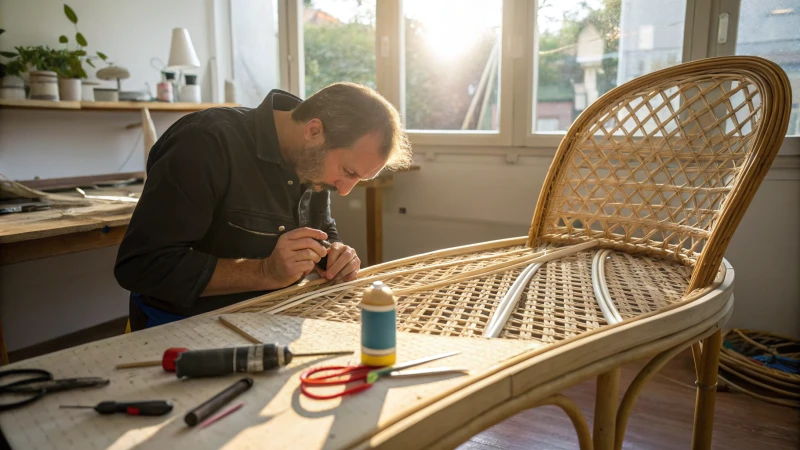
Did you ever look at your favorite rattan chair, old and worn out and think about saving it? I really understand that feeling.
Absolutely! Rattan furniture often gets repaired using methods such as reweaving, gluing and refinishing. These steps are really helpful. They give a fresh look to your favorite pieces. Such repairs are a green choice for home décor. Sustainability is important.
Rattan furniture is often fixable with different methods and tools. This makes it an eco-friendly choice for home décor. I have owned several rattan pieces that needed care. Repair involves reweaving damaged sections and gluing broken parts. With patience, these treasures look beautiful again. Refinishing surfaces helps a lot. It gives them a fresh appearance!
Rattan furniture can be easily repaired with simple tools.True
Many repairs for rattan furniture involve basic tools and techniques, making it accessible for most homeowners.
All types of rattan damage can be fixed without professional help.False
While many repairs are feasible at home, some severe damages may require professional intervention for best results.
What are the most common types of rattan furniture damage?
I have spent years creating beautiful spaces. Keeping rattan furniture looking great is very important. Rattan furniture often faces common problems. Let us explore these issues and find solutions together.
The most common problems with rattan furniture are cracking, fading colors, water damage, loose weave and insect infestations. Regular care really helps. Natural oils and protective covers keep your rattan furniture fresh and vibrant for many years.
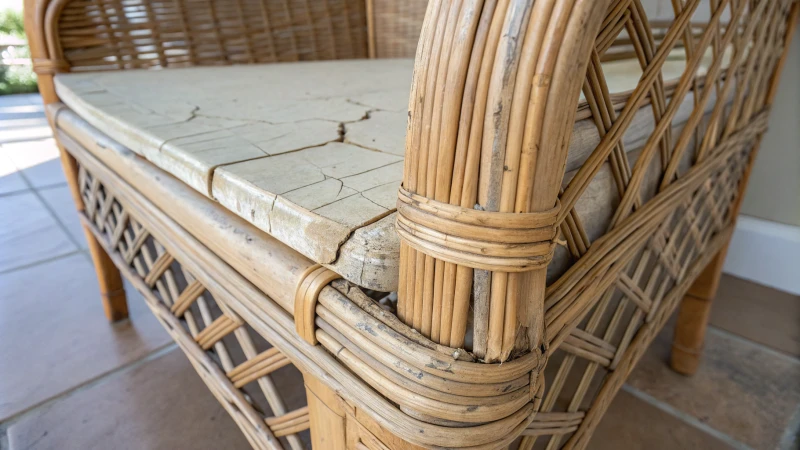
1. Recognizing Harm
Recognizing the kinds of harm that rattan furniture might suffer is important for keeping its beauty and lifespan. Each piece of rattan connects me to nature and skilled work. Experience taught me that good care keeps their allure.
2. Common Issues
Common issues occur often. Let’s see how to fix them.
3. Cracking and Splitting
Rattan furniture is susceptible to cracking and splitting due to changes in temperature and humidity. These fluctuations can cause the rattan to dry out, leading to structural issues.
To prevent this, it’s essential to keep your furniture in a stable environment. Regularly apply a protective sealant designed for rattan to help maintain moisture levels.
For instance, you might consider using natural oils1 that can nourish the fibers and prevent drying out.
4. Fading Colors
Exposure to sunlight can lead to fading colors in rattan furniture. This is particularly true for pieces that are left outdoors or near windows.
To combat fading, consider using outdoor furniture covers or placing your rattan items in shaded areas when not in use. Additionally, UV-protectant sprays can be applied to enhance the longevity of colors. You can find more tips on protecting furniture2.
5. Water Damage
Rattan is not waterproof, and prolonged exposure to water can lead to mold and mildew growth. If your rattan furniture does get wet, make sure to dry it off promptly to avoid any potential damage.
Using a damp cloth followed by thorough drying with a dry cloth is recommended. For more detailed cleaning methods, check out this cleaning guide.
6. Loose Weave or Fraying
Over time, the weaving of rattan can become loose or frayed, especially with frequent use. This not only impacts the aesthetic but can also weaken the structure of the furniture.
To prevent this, inspect your rattan pieces regularly and re-tighten loose strands as needed. Consider a maintenance schedule every few months for deeper checks.
For guidance on repairs, refer to this repair tutorial3.
7. Insect Infestation
Though not as common, insect infestations can occur in rattan furniture, especially if it has been stored improperly. Wood-boring insects may be attracted to untreated rattan.
Regular inspections and treating the wood with insect repellents can help mitigate this risk. Explore more about insect prevention4.
Rattan furniture can crack due to humidity changes.True
Humidity fluctuations cause rattan to dry out, leading to cracks and splits. Maintaining stable conditions is essential for longevity.
Rattan furniture is waterproof and resistant to water damage.False
Rattan is not waterproof; prolonged water exposure leads to mold and mildew. Proper drying is crucial after wetting.
What are the best repair techniques for rattan furniture?
Rattan furniture adds warmth and charm to homes. Over time, it shows signs of wear. The best repair techniques restore its beauty. Repairs keep it functional.
To repair rattan furniture well, try techniques like reweaving. Use glue for fixing breaks. Sand surfaces for smoothness. Varnish the pieces for protection. Replace any damaged rattan strips. Specialized repair kits really help, too. These methods increase the durability of your furniture. They keep your cherished pieces beautiful and appealing.
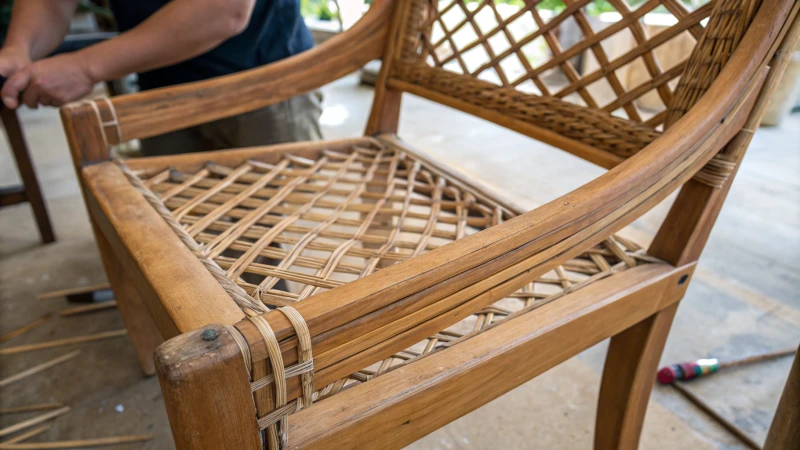
Understanding Rattan Furniture Repair Techniques
Repairing rattan furniture is more than just a task; it’s a trip back to precious moments around that treasured piece. The cozy chair where I enjoyed morning coffee or the beautiful table hosting countless gatherings tell stories through every scratch. This is how I keep my rattan pieces looking great and full of life.
The techniques used depend on the type of damage, whether it’s a simple fray, broken piece, or structural issue. Here are some effective repair methods:
-
Reweaving: The first time I reweaved my grandmother’s old rattan chair felt significant. I use similar rattan strips to carefully fix damaged parts and restore its original beauty.
-
Glue Repair: Joints sometimes come apart. It happens! I use a strong adhesive made for rattan. Eco-friendly glue matches my green values and provides lasting fixes.
-
Sanding and Varnishing: Sanding a worn surface reveals its fresh look! Smoothing splintered edges and using an eco-friendly varnish protect the furniture and makes it shine.
-
Replacement of Rattan Strips: Sometimes, damage is too big for a quick fix. I swap out entire rattan strips by carefully removing old ones and adding new ones. It’s hard work but very rewarding!
-
Using Repair Kits: I have found repair kits5 made for rattan furniture. These kits usually have everything needed – adhesives, weaving materials, and instructions – for simple repairs.
Essential Tools for Rattan Repair
| Tool | Purpose |
|---|---|
| Craft Knife | For cutting and trimming rattan strips |
| Weaving Needle | To facilitate the reweaving process |
| Sandpaper | For smoothing surfaces before finishing |
| Eco-friendly Glue | For bonding broken joints or strips |
| Spray Varnish | To protect and finish the repaired areas |
Professional vs DIY Repairs
I often think about doing DIY repairs or hiring professionals:
- DIY Repair: Repairing things myself saves money. It’s very satisfying to restore something special. I feel proud knowing I can do it myself.
- Professional Repair: If damage is complicated, I call professionals. Expert work makes a big difference, especially for cherished pieces.
Maintenance Tips for Longevity
To keep my rattan furniture lasting long, I follow these tips:
- Keeping pieces out of direct sunlight prevents fading.
- Regular dusting and cleaning with a damp cloth stops dirt buildup.
- Keeping cushions inside during rain avoids mold problems.
- Applying protective finishes sometimes improves durability and looks.
With these techniques understood, my rattan furniture stays beautiful and useful for years.
Reweaving is essential for repairing loose rattan furniture.True
Reweaving restores the original look of rattan furniture by using similar strands to fix damaged sections.
Sanding and varnishing are unnecessary for rattan maintenance.False
Sanding and applying eco-friendly varnish rejuvenate and protect worn rattan surfaces, enhancing durability.
What tools and materials do you need for rattan repairs?
Do you want to give fresh life to your rattan furniture? Join me while I share the important tools and materials for repairs. These tools and materials probably allow for professional work. Do these repairs at home. You really can become a pro.
First, collect needed tools like scissors, pliers and clamps to fix rattan furniture. Use adhesives, including rattan glue and wood glue, for the task. Safety gear is important! Wear gloves and dust masks for a secure DIY project.
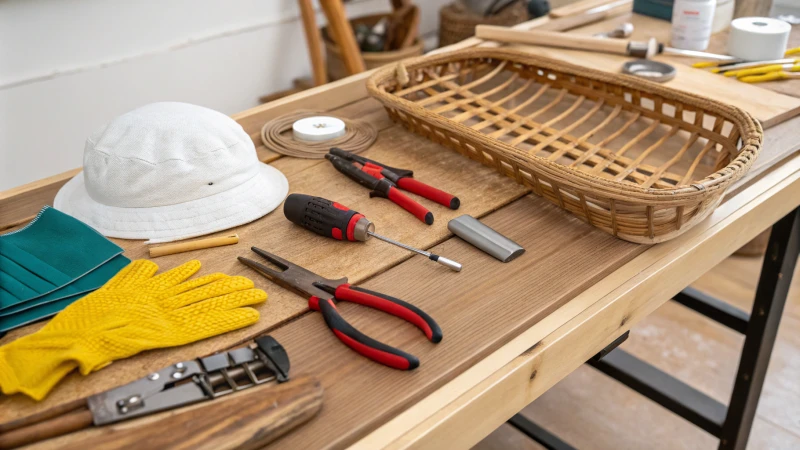
Fixing rattan furniture is really satisfying. The first time I worked on an old rattan chair, it felt amazing to make it look new again. This joy came after some effort. You need the right tools and materials. Let’s get started!
Basic Tools Required
- Scissors or Snips: Use these to cut rattan strands to the right length. A sharp pair is very useful.
- Pliers: These help a lot for tightening or bending wire supports.
- Screwdriver: This tool handles screws to keep repairs stable.
- Clamps: Clamps hold parts in place while glue dries. They are essential.
Adhesives and Finishes
| Material | Purpose |
|---|---|
| Rattan Glue | Specifically designed for bonding rattan. |
| Wood Glue | Great for general wood bonding, can be used on rattan. |
| Varnish or Lacquer | This adds a final touch to protect the repaired piece. |
Choosing the right adhesive is important for making strong repairs. I am trying out eco-friendly adhesives6. They are better for the environment. Maybe you can try them too!
Replacement Materials
Sometimes, the damage is too much. That’s okay! Here are some replacement options:
- Rattan Strips: Available in different widths for weaving into your piece, giving it a new appearance.
- Synthetic Rattan: Tougher than natural rattan and great for outdoor furniture.
Safety Gear
Repairing rattan is fun and safe with proper gear:
- Gloves: Protect your hands from sharp tools and sticky adhesives.
- Dust Mask: Keeps your lungs safe when sanding or cutting.
Having these tools and materials will probably lead to success in your repair project. Local suppliers might offer convenient DIY rattan repair kits7.
Additional Resources
Improve your skills with tutorials or workshops. Learning rattan weaving techniques8 has really helped me feel more confident. With the right tools and knowledge, you can fix any rattan furniture confidently! Restoring your furniture is very rewarding.
Rattan glue is essential for effective rattan repairs.True
Using rattan glue ensures a strong bond specifically designed for rattan materials, enhancing the durability of your repair.
Safety gear is unnecessary for rattan repairs.False
Safety gear like gloves and dust masks is crucial to protect against sharp tools and harmful dust during repairs.
How can you prevent further damage to your rattan furniture?
Rattan furniture looks beautiful and provides comfort. It is also an investment. I have learned to care for it over the years. Care helps it stay in good condition.
To stop more harm to your rattan furniture, use UV protection, control moisture and follow a regular care routine. This helps keep furniture beautiful and strong. Trust me; it really matters!
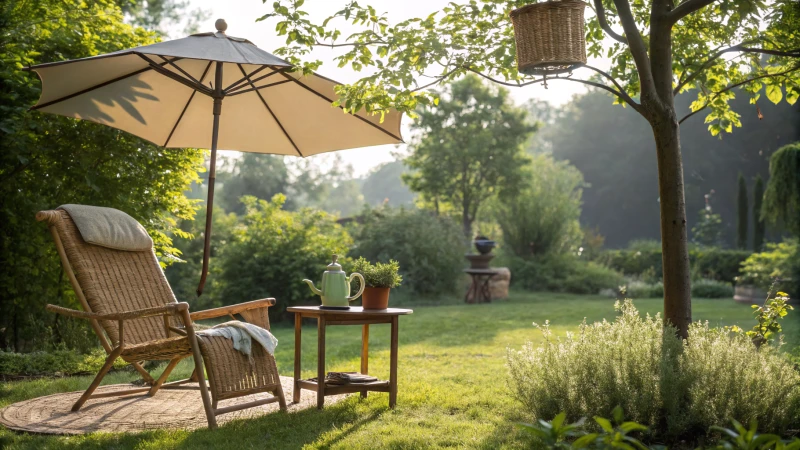
Understanding Rattan’s Vulnerabilities
Rattan furniture, while beautiful and durable, is not immune to damage from environmental factors.
Sunlight, moisture, and even dust can compromise its integrity over time.
To combat these issues, it’s essential to implement protective measures that keep your rattan pieces looking their best.
- UV Protection: Direct sunlight can cause fading and brittleness in rattan. Taking steps to shield it from UV rays really helps. Consider using UV-resistant covers9 when your furniture is outdoors.
- Moisture Control: Managing how much moisture it faces is also crucial as rattan is susceptible to mold and mildew if exposed to excess moisture. Ensure proper ventilation and use waterproof sprays designed for natural fibers to help protect your furniture.
Maintenance Tips for Longevity
Regular maintenance is key in extending the life of your rattan furniture. Here’s a simple table outlining a maintenance schedule:
| Maintenance Task | Frequency | Details |
|---|---|---|
| Dusting | Weekly | Use a soft cloth or vacuum with a brush attachment. |
| Deep Cleaning | Monthly | Clean with a damp cloth; avoid soaking the rattan. |
| Check for Damage | Bi-Monthly | Inspect joints and weave for signs of wear or loosening. |
| Reapply Protective Coating | Annually | Use a suitable rattan oil or sealant for protection. |
Protective Products to Consider
Investing in the right products can make a significant difference in the durability of your rattan furniture. Here are some recommendations:
- Rattan Cleaner: A gentle cleaner specifically designed for natural fibers can help remove dirt without damaging the material. Explore options like Eco-Friendly Rattan Cleaners10.
- Waterproof Spray: Products that add a protective layer against moisture will enhance durability. Look for Waterproofing Options11 that are safe for rattan use.
Seasonal Care Tips
Different seasons bring unique challenges for maintaining rattan furniture. Here are tailored tips for each season:
- Spring: Clean and check for any winter damage; apply protective coatings if necessary.
- Summer: Ensure your furniture is shaded from intense sunlight; consider using outdoor covers during peak sun hours.
- Fall: Regularly remove leaves and debris that could trap moisture against the rattan.
- Winter: If possible, store furniture indoors or in a protected area to prevent exposure to harsh weather conditions.
By sticking to regular care routines, you can greatly reduce the risk of damage to your rattan furniture and preserve its natural beauty and functionality for years to come.
Rattan furniture can be damaged by direct sunlight.True
Direct sunlight causes fading and brittleness in rattan furniture, making it essential to protect it from UV rays.
Moisture does not affect rattan furniture durability.False
Excess moisture can lead to mold and mildew, compromising the integrity of rattan furniture over time.
Conclusion
Learn effective techniques for repairing rattan furniture, including reweaving and gluing, while maintaining its beauty and durability against common issues.
-
Discover insights on how to protect your rattan furniture from damage and enhance its durability. ↩
-
Learn effective cleaning methods tailored for rattan furniture maintenance. ↩
-
Find step-by-step instructions for repairing damaged rattan weaving. ↩
-
Understand how to prevent insect infestations in your rattan products. ↩
-
Learn about sustainable adhesives perfect for rattan furniture repairs in this detailed guide. ↩
-
Clicking this link provides access to eco-friendly adhesives that are perfect for sustainable rattan repairs. ↩
-
This link leads to a convenient DIY rattan repair kit, making your project much easier. ↩
-
Explore this link for comprehensive tutorials on rattan weaving techniques to boost your skills. ↩
-
Discover essential tips and tricks to enhance the longevity of your rattan furniture by preventing damage. ↩
-
Learn about eco-friendly products that can help maintain your rattan’s beauty while being gentle on the environment. ↩
-
Explore comprehensive guides on seasonal care routines to keep your rattan furniture in top shape year-round. ↩

